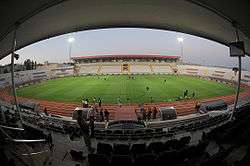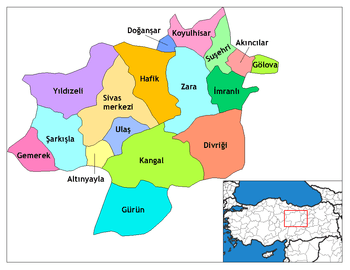Sivas
Sivas (Latin and Greek: Sebastia, Sebastea, Sebasteia, Sebaste, Σεβάστεια, Σεβαστή; Armenian: Սեբաստիա;) is a city in central Turkey and the seat of Sivas Province.
Sivas Sebastea | |
|---|---|
 | |
 Sivas | |
| Coordinates: 39°45′N 37°01′E | |
| Country | Turkey |
| Province | Sivas |
| Government | |
| • Mayor | Sami Aydın (AKP) |
| Area | |
| • District | 2,768.18 km2 (1,068.80 sq mi) |
| Elevation | 1,285 m (4,216 ft) |
| Population (2012)[2] | |
| • Urban | 312,587 |
| • District | 346,629 |
| • District density | 130/km2 (320/sq mi) |
| Website | www.sivas.bel.tr |
The city, which lies at an elevation of 1,278 metres (4,193 ft) in the broad valley of the Kızılırmak river, is a moderately-sized trade center and industrial city, although the economy has traditionally been based on agriculture. Rail repair shops and a thriving manufacturing industry of rugs, bricks, cement, and cotton and woolen textiles form the mainstays of the city's economy. The surrounding region is a cereal-producing area with large deposits of iron ore which are worked at Divriği.
Sivas is also a communications hub for the north–south and east–west trade routes to Iraq and Iran, respectively. With the development of railways, the city gained new economic importance as junction of important rail lines linking the cities of Ankara, Kayseri, Samsun, and Erzurum. The city is linked by air to Istanbul. The popular name Sebastian derives from Sebastianòs, Σεβαστιανός, meaning someone from the city.[3][4]
Name
The name of the city is a truncated form of its Byzantine Greek name Sivasteia from the Koine Greek name Sebasteia (Σεβαστεία), which derives from the Greek word σεβαστός (sebastos), "venerable",[5] σέβας (sebas), "awe, reverence, dread",[6] and the verb σέβομαι (sebomai), "feel awe, scruple".[7] Sebastos was the Greek translation of the title Augustus, which was used for Roman emperors.
History
Ancient and medieval
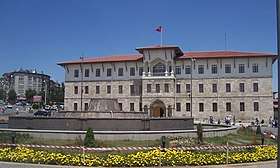
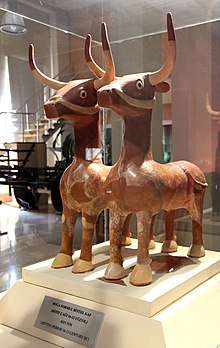

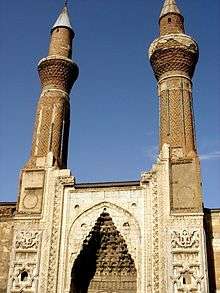
Little is known of Sivas' history prior to its emergence in the Roman period. In 64 BC as part of his reorganization of Asia Minor after the Third Mithridatic War, Pompey the Great founded a city on the site called "Megalopolis".[8] Numismatic evidence suggests that Megalopolis changed its name in the last years of the 1st century BC to "Sebaste", which is the feminine form of the Greek name corresponding to Augustus. The name "Sivas" is the Turkish version deriving from the name Sebasteia, as the city was known during the late Roman (Byzantine) empire. Sebasteia became the capital of the province of Armenia Minor under the emperor Diocletian, was a town of some importance in the early history of the Christian Church; in the 4th century it was the home of Saint Blaise and Saint Peter of Sebaste, bishops of the town, and of Eustathius, one of the early founders of monasticism in Asia Minor. It was also the place of martyrdom of the Forty Martyrs of Sebaste, also 4th century. Justinian I had a fortified wall around it rebuilt in the 6th century.
Sebasteia was the first important city to be plundered by Turkish tribes in 1059.[9] In August of that year the troops of various emirs gathered before the unwalled city. Initially they hesitated to sack it, mistaking that the domes of the several Christian churches were tents of military camps. As soon as they realized that the city was defenceless they burned it for eight days, slaughtered a large part of its population and took many prisoners.[10] The city came under the domain of Turkmen Danishmend dynasty (1071–1174) after the Battle of Manzikert in 1071. After the death of Danişmend Gazi, Sivas passed to Nizamettin Yağıbasan who won it after a struggle with Danişmend Gazi's successors. In 1174, the city was captured by Seljuk ruler Kilij Arslan II and periodically served as capital of the Seljuk empire along with Konya. Under Seljuk rule, Sivas was an important center of trade along the silk road and site of a citadel, along with mosques and madrasahs (Islamic educational institutions), four of which survive today and one of which houses the Sivas Museum. Then it passed to the Ilkhanids, Eretna and Kadı Burhanettin.

The city was acquired by Ottoman Sultan Bayezid I (1389–1402). In 1398, Tamerlane swept into the area and his forces destroyed the city in 1400, after which it was recaptured by the Ottomans in 1408.[11] Under the Ottomans, Sivas served as the administrative center of the province of Rum until about the late 19th century. The Armenian Apostolic Church maintained six Armenian churches in Sivas, being the Meryemana, Surp Sarkis, Surp Minas, Surp Prgitsh, Surp Hagop, Surp Kevork, four monasteries Surp Nschan, Surp Hreshdagabed, Surp Anabad, Surp Hntragadar, an Armenian Apostolic orphanage and several schools. The Armenian Catholic Church and the Latins also had one church and a metropolitan of Sebastea, as did the Greek Orthodox Church.[12] Two Protestant churches and eight, mostly German- and American-staffed, schools. During the genocide against Armenians as well as against Greek Christians from July 5, 1915 onwards, the Christian community of Sivas was exterminated by deportations and mass executions.[13]
The Sivas Congress (Heyet-i Temiliye) was held in this city 4–11 September 1919.[14] With the arrival of Mustafa Kemal Atatürk (1881–1938), the founder of the Turkish Republic, from Amasya, the Congress of Sivas is considered a turning point in the formation of the Turkish Republic. It was at this congress that Atatürk's position as chair of the executive committee of the national resistance was confirmed (see Turkish War of Independence). Sivas was depicted on the reverse of the Turkish 500 lira banknote of 1927–1939.[15]
On 2 July 1993, 37 participants in an Alevi cultural and literary festival were killed when a mob of demonstrators set fire to the Madimak hotel in Sivas during a violent protest by some 15,000 members of various radical Islamist groups against the presence of Aziz Nesin. The deaths resulted in the Turkish government taking a harder stance against religious fanaticism, militant Islam, and antisecularism. In late 2006, there was a campaign by the Pir Sultan Abdal Cultural Institute to convert the former hotel into a museum to commemorate the tragedy, now known as the Sivas massacre.
Climate
Sivas has a warm dry-summer continental climate (Köppen climate classification: Dsb), with warm and dry summers and cold and snowy winters. The driest months are July and August and the wettest are April and May.
| Climate data for Sivas | |||||||||||||
|---|---|---|---|---|---|---|---|---|---|---|---|---|---|
| Month | Jan | Feb | Mar | Apr | May | Jun | Jul | Aug | Sep | Oct | Nov | Dec | Year |
| Record high °C (°F) | 14.6 (58.3) |
17.5 (63.5) |
25.0 (77.0) |
29.0 (84.2) |
32.0 (89.6) |
35.2 (95.4) |
40.0 (104.0) |
39.4 (102.9) |
34.6 (94.3) |
30.3 (86.5) |
22.8 (73.0) |
19.4 (66.9) |
40.0 (104.0) |
| Average high °C (°F) | 0.8 (33.4) |
2.4 (36.3) |
8.2 (46.8) |
15.2 (59.4) |
20.0 (68.0) |
24.0 (75.2) |
27.9 (82.2) |
28.4 (83.1) |
24.6 (76.3) |
18.4 (65.1) |
10.5 (50.9) |
3.8 (38.8) |
15.4 (59.6) |
| Daily mean °C (°F) | −3.3 (26.1) |
−2.1 (28.2) |
3.0 (37.4) |
9.1 (48.4) |
13.6 (56.5) |
17.2 (63.0) |
20.2 (68.4) |
20.1 (68.2) |
16.2 (61.2) |
10.9 (51.6) |
4.6 (40.3) |
−0.4 (31.3) |
9.1 (48.4) |
| Average low °C (°F) | −7.1 (19.2) |
−6.3 (20.7) |
−1.6 (29.1) |
3.5 (38.3) |
7.3 (45.1) |
10.1 (50.2) |
12.3 (54.1) |
12.0 (53.6) |
8.4 (47.1) |
4.6 (40.3) |
−0.1 (31.8) |
−3.9 (25.0) |
3.3 (37.9) |
| Record low °C (°F) | −34.6 (−30.3) |
−29.6 (−21.3) |
−27.6 (−17.7) |
−10.9 (12.4) |
−2.0 (28.4) |
−0.3 (31.5) |
3.6 (38.5) |
3.2 (37.8) |
−0.8 (30.6) |
−5.8 (21.6) |
−21.0 (−5.8) |
−27.0 (−16.6) |
−34.6 (−30.3) |
| Average precipitation mm (inches) | 40.1 (1.58) |
38.3 (1.51) |
46.0 (1.81) |
65.7 (2.59) |
60.3 (2.37) |
33.9 (1.33) |
11.2 (0.44) |
7.6 (0.30) |
18.3 (0.72) |
37.8 (1.49) |
41.6 (1.64) |
43.9 (1.73) |
444.7 (17.51) |
| Average rainy days | 12.3 | 11.9 | 13.3 | 14.7 | 14.3 | 8.7 | 3.2 | 3.0 | 4.7 | 8.3 | 9.7 | 12.3 | 116.4 |
| Average snowy days | 9 | 9 | 7 | 1 | 0 | 0 | 0 | 0 | 0 | 0 | 3 | 7 | 36 |
| Average relative humidity (%) | 77 | 77 | 72 | 64 | 61 | 57 | 53 | 52 | 54 | 62 | 72 | 76 | 65 |
| Mean monthly sunshine hours | 77.5 | 95.2 | 151.9 | 186 | 257.3 | 318 | 372 | 359.6 | 291 | 198.4 | 120 | 71.3 | 2,498.2 |
| Source 1: Devlet Meteoroloji İşleri Genel Müdürlüğü[16] | |||||||||||||
| Source 2: Climate and Temperature[17] Weather2[18] | |||||||||||||
Economy

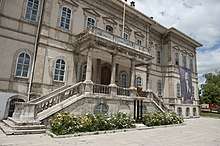
Historically, Sivas was known for producing cereal. As of 1913, Sivas produced 79,000 tons of cereal, making it a major, and successful, industry.[19] Sivas also had orchards, exporting produce to Constantinople.[20] Alfalfa and copper was also produced in the area.[21][22] Sericulture was seen in Sivas before 1914.[23]
Sights
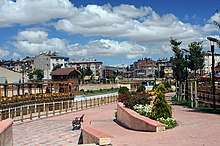

A cultural hub as well as an industrial one, Sivas contains many examples of 13th-century Seljuk architecture. The Mavi Medrese from 1271, the Şifaiye Medresesi from 1218 and the Çifte Minare Medresesi from 1271, with its intricately carved façade and minarets, are among the most noteworthy monuments. The city is also famous for its Medreses (Islamic seminaries). Gök Medresesi (the Celestial Madrasa; depicted on the obverse of the Turkish 500 lira banknote of 1927-1939[15]) and Mavi Medrese, Sifaiye Medresesi, on the other hand, was completed earlier, on the eve of the second wave of Turkic migration to Anatolia, in 1218 and with its intricately carved façade and minarets are among the most noteworthy edifices carries on the traditional Seljuk Medrese plan.
The city also contains some fine examples of the Ottoman architectural style. Kurşunlu Hamamı (Leaden Bath) which was completed in 1576, is the largest Turkish bath in the city and it contains many details from the classical Ottoman bath building. Behrampaşa Hanı (Caravansaray), was completed in 1573 and it is famous for the lion motifs around its windows.
Atatürk Congress and Ethnography Museum (Atatürk Kongre ve Etnografya Müzesi) is a museum with two sections. One is a dedicated to the Ottoman heritage of Sivas. The other is to the Sivas Congress, one of the pivotal moments in the Turkish national movement.
The modern heart of the city is Hükümet Square (Hükümet Meydanı, also called Konak Meydanı) located just next to the Governor's mansion. This area is also home to many of the city's high end hotels and restaurants. The city's shoppers usually head to Atatürk Avenue.
Sivas is also famous for its thermal springs which have a respectable percentage in the city's income. People believe that the water of these thermal springs can cure many illnesses. The most famous thermal areas are, Sıcak Çermik, Soğuk Çermik and Kangal Balıklı Kaplıca.
Sports
Football is the most popular sport: in the older districts above the city center children often kick balls around in the evenings in the smallest streets. The city's football club is Sivasspor, which plays its games at the New Sivas 4 Eylül Stadium. The club currently plays in Süper Lig.
Museums
- Sivas Congress and Ethnography Museum
- Sivas Archaeology Museum
- Madimak Science and Culture Centre[24]
Madrasahs
- Buruciye Madrasah
- Çifte Minareli Madrasah (Double Minaret Madrasah)
- Gök Medresesi (Blue Madrasah)
- Şifaiye Medrese
 Sivas Buruciye Medrese From right of entrance
Sivas Buruciye Medrese From right of entrance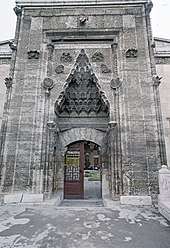 Sivas Buruciye Medrese Entrance
Sivas Buruciye Medrese Entrance Sivas Buruciye Medrese Looking up at entrance
Sivas Buruciye Medrese Looking up at entrance Sivas Buruciye Medrese Decoration right side of entrance
Sivas Buruciye Medrese Decoration right side of entrance Sivas Buruciye Medrese Courtyard in old situation
Sivas Buruciye Medrese Courtyard in old situation Sivas Buruciye Medrese Courtyard in 2011
Sivas Buruciye Medrese Courtyard in 2011 Sivas Buruciye Medrese Tombs
Sivas Buruciye Medrese Tombs Çifte Minare Medrese Entrance
Çifte Minare Medrese Entrance Çifte Minare Medrese Decoration entrance
Çifte Minare Medrese Decoration entrance Çifte Minare Medrese From back after restoration
Çifte Minare Medrese From back after restoration Çifte Minare Medrese Decoration detail
Çifte Minare Medrese Decoration detail Çifte Minare Medrese Kufic style tiles on base minaret
Çifte Minare Medrese Kufic style tiles on base minaret Çifte Minare Medrese Decoration detail
Çifte Minare Medrese Decoration detail Çifte Minare Medrese Decoration detail
Çifte Minare Medrese Decoration detail Gök Medresesi before restoration Portal detail
Gök Medresesi before restoration Portal detail Gök Medresesi before restoration Portal from left side
Gök Medresesi before restoration Portal from left side Gök Medresesi during restoration shot from right side
Gök Medresesi during restoration shot from right side Sivas Şifaiye Medrese Courtyard after restoration
Sivas Şifaiye Medrese Courtyard after restoration Sivas Şifaiye Medrese At tombs
Sivas Şifaiye Medrese At tombs Sivas Şifaiye Medrese Tiled decoration
Sivas Şifaiye Medrese Tiled decoration
Cuisine
Specialties of Sivas are tarhana (a soup made using sour yogurt), kelecos (a sour potato soup made with yoghurt) and katmer, a kind of flatbread. One distinct feature of Sivas cooking is the use of madimak, which is a local herb used similarly to spinach. Sivas kebabı is a variety of kebab originating from Sivas.
International relations
Twin towns and sister cities
Sivas is twinned with:[25]


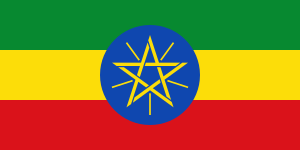




See also
- List of people from Sivas
- Şifaiye Medrese
- Sivas Congress
- Kangal Dog
- Kangal Fish
- Divriği Great Mosque
- Rûm Eyalet
- Sivas massacre
References
- "Area of regions (including lakes), km²". Regional Statistics Database. Turkish Statistical Institute. 2002. Retrieved 2013-03-05.
- "Population of province/district centers and towns/villages by districts - 2012". Address Based Population Registration System (ABPRS) Database. Turkish Statistical Institute. Retrieved 2013-02-27.
- Julia Cresswell (5 November 2007). Naming Your Baby: The Definitive Dictionary of First Names. A&C Black. p. 209. ISBN 978-0-7136-8313-4.
- Davis, J. Madison (1995). The Shakespeare Name and Place Dictionary. Routledge. p. 444. ISBN 978-1-884964-17-6.
- σεβαστός, c.f. Henry George Liddell, Robert Scott, A Greek-English Lexicon, on Perseus
- σέβας, Henry George Liddell, Robert Scott, A Greek-English Lexicon, on Perseus
- σέβομαι, Henry George Liddell, Robert Scott, A Greek-English Lexicon, on Perseus
- A.H.M. Jones, The Cities of the Eastern Roman Provinces, 2nd ed. (Oxford University Press, 1971), 159.
- Rosser, John H. Historical dictionary of Byzantium (2nd ed.). Lanham, Maryland: Scarecrow Press. p. 425. ISBN 9780810875678.
- Speros Vryonis, The Decline of Medieval Hellenism in Asia Minor and the Process of Islamization from the Eleventh through the Fifteenth Century (University of California Press, 1971), p. 155
- Henry Hoyle Howorth: History of the Mongols from the 9th to the 19th Century, 2008, p. 166
- Pars Tuğlacı: Tarih boyunca Batı Ermenileri tarihi. Cilt 3. (1891 – 1922), Pars Yayın ve Tic., Istanbul und Ankara 2004 ISBN 975-7423-06-8, p. 43
- Raymond Kévorkian: Le Génocide des Arméniens; Odile Jacob, Paris 2006, p. 542
- Halil Gülbeyaz: Mustafa Kemal Atatürk. Vom Staatsgründer zum Mythos, Parthas, Berlin 2003, p. 87
- Central Bank of the Republic of Turkey Archived 2009-06-03 at WebCite. Banknote Museum: 1. Emission Group - Five Hundred Turkish Lira - I. Series. – Retrieved on 20 April 2009.
- "İl ve İlçelerimize Ait İstatistiki Veriler- Meteoroloji Genel Müdürlüğü". Archived from the original on 2011-06-20.
- "Weather Averages for Sivas, Turkey Climate ]".
- {{cite web |url=http://www.myweather2.com/City-Town/Turkey/Sivas/climate-profile.aspx |title=September Climate History for Sivas | Local | Turkey ]
- Prothero, W.G. (1920). Armenia and Kurdistan. London: H.M. Stationery Office. p. 60.
- Prothero, W.G. (1920). Armenia and Kurdistan. London: H.M. Stationery Office. p. 62.
- Prothero, W.G. (1920). Armenia and Kurdistan. London: H.M. Stationery Office. p. 63.
- Prothero, W.G. (1920). Armenia and Kurdistan. London: H.M. Stationery Office. p. 74.
- Prothero, W.G. (1920). Armenia and Kurdistan. London: H.M. Stationery Office. p. 64.
- sitesi, milliyet.com.tr Türkiye'nin lider haber. "Madımak oteli Bilim ve Kültür Merkezi oldu". MİLLİYET HABER - TÜRKİYE'NİN HABER SİTESİ. Retrieved 2018-01-05.
- Uzaklar Yakinlaşti - Sivas Twin Towns Archived 2013-12-27 at the Wayback Machine(in Turkish)
- "National Commission for Decentralised cooperation". Délégation pour l'Action Extérieure des Collectivités Territoriales (Ministère des Affaires étrangères) (in French). Archived from the original on 2013-10-04. Retrieved 2013-12-26.
